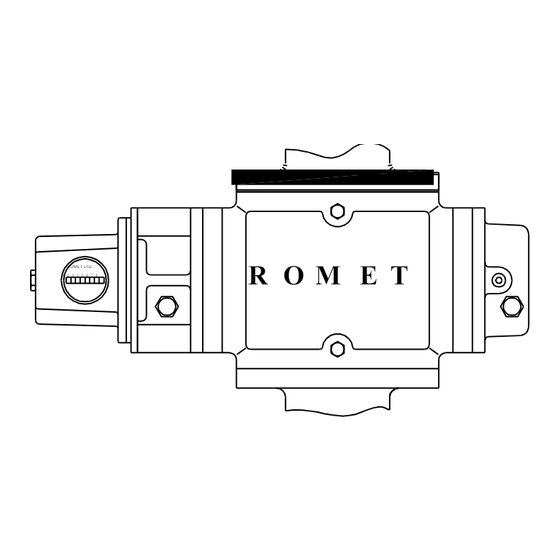
Advertisement
Quick Links
INSTALLATION & MAINTENANCE
RM600 – RM56000
➢
This bulletin covers the general installation of all
ROMET rotary meters.
➢
A Romet meter is a precise gas volume measuring
instrument (cash register), manufactured to very
tight tolerances. Rough handling of the meter must
be avoided to prevent damage.
➢
To prevent external/internal damage, dirt or oil
contamination of the meter, always transport the
meter in a protective container with the meter
capped at both opening ends, including the
instrument drive assembly (if applicable), and
WITHOUT oil.
➢
Always add oil after the meter has been correctly
installed at the meter site.
➢
Installation of a Romet rotary meter is a relatively
simple procedure if the meter set is properly
constructed. The piping and flange position of the
meter set should be such that there is adequate
area spacing between the meter and any pipe, wall
or any other possible obstruction. This spacing will
allow for ease of maintenance or the addition or
removal of devices; such as, a meter module,
batteries or any other auxiliary instruments.
➢
Furthermore, all full faced pipe flanges installed
(raised flanges are not recommended) must be
level and spaced so that the meter together with
the top and bottom gaskets can be positioned
between the flanges easily and with the least
amount of air gap (maximum 1/16" (1.6 mm) per
linear foot (30.5 cm) of flange) before tightening. If
the meter is not level, it is possible to improperly fill
the oil reservoirs or over-stress the meter after
tightening the flange bolts.
cause the meter to read incorrectly or result in
complete meter failure.
Care must also be taken to ensure that the piping
and flanges are aligned correctly in relation to the
meter (maximum 1/16" (1.6mm) in all directions).
DO NOT use the meter to correct misaligned piping
or flanges.
Excessive misalignment or distance
between piping or flanges may over-stress the
meter body when the flange bolts are tightened.
Severe over-stress may cause the meter to read
incorrectly or result in complete meter failure.
The use of a "spool piece" is recommended to help
level and align piping and/or flanges in relation to
the meter before meter installation. These spools
are available from Romet.
➢
To protect the meter (and any other critical
devices) from internal damage, the gas passing
through a meter set must be clean (i.e. free of rust,
scale, grease, pipe paste, wadding, weld beads,
etc.).
Installation Instructions
Line Mounted ROMET Meters
RM16 – RM1600
This condition may
for
The use of a filter (e.g. Romet Screen "T" filter,
typically 60 mesh/250 micron size) or strainer
installed upstream of the meter set is strongly
recommended to insure adequate internal meter
protection.
➢
Before installing a Romet meter, a quick check
should be performed.
First, remove the meter from the protective
container and check the overall condition for any
possible damage or any other problems. Remove
the capping from each end of the meter openings.
Lightly blow some air into the inlet of the meter.
This should cause the impellers to rotate freely and
eventually come to a gradual stop.
Should the impellers stop suddenly or not rotate
after blowing into the meter, it will be necessary to
carefully
remove
installation. If this is not possible, the meter should
be returned to the service shop for further
examination.
➢
Ensure that the meter is mounted in the correct gas
flow arrow direction and position.
normally installed using the following hardware
items listed in Table 1.
hardware may result in meter error or failure.
bolts should be tighten in a X pattern, in stages, up
to a typical torque value of 80 ft·lbs (110 N·m).
Some Romet meters are supplied with nippled
connections at the inlet and outlet. These meters
are built and tested with the connecting nipples in
place.
Care must be taken to avoid further
tightening or loosening of these nipples to prevent
meter damage. Install auxiliary instrumentation as
required.
➢
After the meter has been properly installed,
approved meter oil must be added to all
appropriate oil reservoirs to prevent possible meter
errors or damage. Depending on the meter type
and mounting position (vertical or horizontal), the
required oil volumes will be different. DO NOT over
or under fill oil reservoirs. For the thrust cover end
and the magnetic housing (not found on all meter
types), oil must be added so that the oil reaches the
centre point of the correct oil level gauge (OLG) in
use. For the module cover, the oil must reach the
appropriate RED oil level line (note - centre point of
the OLG for standard counter modules).
DO NOT fill electronic sections with oil.
Note: After meter start up, some oil levels may drop
a little and/or form a thin bubble or meniscus layer
due to oil splash happening within the oil reservoir.
- Refer to "Oil Loss Bulletin", Rev. OL-0111.
BULLETIN No. 601
June 11, 2018 Rev.18
G10 – G1000
any
obstruction
Meters are
The use of incorrect
before
All
Advertisement

Summary of Contents for Romet RM600
- Page 1 RM600 – RM56000 RM16 – RM1600 G10 – G1000 ➢ The use of a filter (e.g. Romet Screen “T” filter, This bulletin covers the general installation of all ROMET rotary meters. typically 60 mesh/250 micron size) or strainer installed upstream of the meter set is strongly ➢...
- Page 2 Approved meter oil: High VI R&O AW ISO VG 15 installed downstream of the meter to protect the red, is available from Romet in one quart (litre) meter from damage. plastic bottles. Other approved oil: Shell Morlina S2 ➢ Check for any gas leaks or other possible problems.